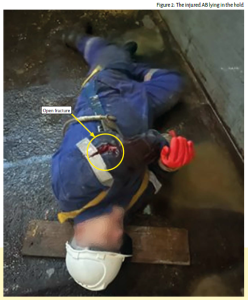Safety Alert: Hooking on whilst working at height
A cargo vessel alongside in port had completed discharging animal feed. The cargo hold was empty and the hatches open. It was dark and raining.
The vessel’s crew were instructed on the risk assessments for working in the hold and signed the working at height form. They entered and installed a single spotlight at the aft end of the hold and began moving the hold’s internal dividing bulkheads. Several hours later, the ship’s cook/AB was working at the forward hold bulkhead wearing a safety harness with a lanyard and safety hook. The AB used recessed footholds in the side of the cargo hold to climb about 2.5m to access one of the bulkhead locking bolts and attached the safety hook. The AB was unable to reach the locking bolt and, using one hand to hold on, disconnected the safety hook and attempted to move it to another position. The AB slipped from the foothold and handholds before the safety hook could be attached to a securing point.
The AB fell to the hold bottom, fracturing their upper arm. Due to difficulties of lifting the casualty out of the hold bottom, medical attention was administered at the scene for over an hour before the AB could be recovered to a waiting ambulance and transferred to hospital for further treatment.
Learning points:
Equipment:
The safety harness was equipped with only one lanyard and hook. Once unhooked there is no fall arrest/prevention apart from hand and footholds; this might be unsuitable in the local conditions. A twin lanyard/hook harness could have enabled movement at height while providing a means of fall prevention.
Risk:
It was inappropriate for the AB to be working at height in the dark and rain with insufficient lighting. The ship’s work at height risk assessments did not include such factors, demonstrating that all realistic scenarios in which crew might be expected to work had not been considered and resulting in documentation that was of limited safety value.
Procedure:
The ship did not have procedures or equipment to recover an injured person from the cargo hold. Without suitable crew training and recovery equipment a survivable injury can become a fatality.
FOR THE FULL REPORT, CLICK HERE
This report is included in MAIB safety digest: volume 1, 2024 https://assets.publishing.service.gov.uk/media/66068f1bf9ab416792eea372/2024-SD1-SafetyDigest.pdf
ICHCA International is committed to helping industry to learn lessons fast, learn them once and make sure that they stay learnt. This information is intended to provide all organisations in the cargo supply chain with the opportunity to consider the events and to review and adapt their own health and safety control measures to proactively prevent future incidents.
We are grateful to MAIB for providing details and for raising awareness. We acknowledge their commitment to sharing learning to benefit others. If you have similar operations, please share this information with managers, operatives and any potentially affected third parties as appropriate. Please also review any of your relevant operations for similar hazardous conditions, risks, and controls. Learning content like this is highly valuable as it is based on real-world experience. We encourage everyone with publishable information about incidents to send it to us, so that we can raise awareness across the whole industry. Please contact us at secretariat@ichca.com; sharing your insight could save a life or prevent injury.


